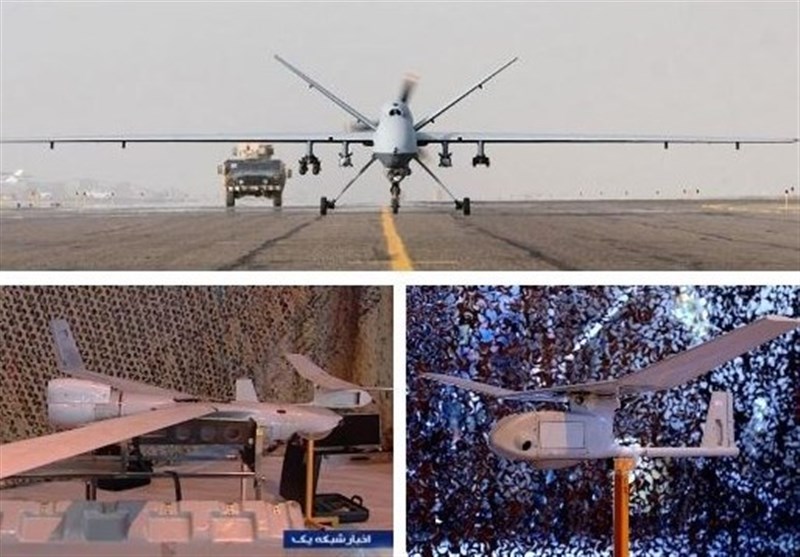AhlulBayt News Agency (ABNA): While expulsion of the American forces from West Asia have been a key plan of the Axis of Resistance over the past two years and the once-large number of the US military bases has been on the decline with exit from Afghanistan and Iraq of the American forces, Washington announced new sanctions on organizations and figures assisting Iran’s drone program amid its push to reinstall the restrictions on Tehran’s peaceful nuclear program.
On Saturday, Secretary of State Antony Blinken announced new sanctions on a number of organizations and figures, claiming that the White House will use the means available to prevent transfer of material and technology used in Iran drone industry.
The move also comes as Iran last week held a major joint military exercise by the IRGC and the army using drone and defense capabilities. Shortly after, Washington announced a joint drone exercise with Bahrain in the Persian Gulf waters.
Why is the US afraid of Iran drone capabilities?
Undoubtedly, the main reason for imposing new White House sanctions on Iran's military-defense capability is to prevent the development of the country's deterrent capability. Acquiring technology of advanced military ware has always been an important element in world governments' efforts to protect their interests in the highly competitive international environment. In recent years, meanwhile, there has been a shift towards greater capabilities in long-range warfare that facilitate military actions without the need for costly personnel campaigns. When it comes to this area, the state-of-the-art combat-surveillance drones and supersonic missiles shrine.
In the past years, Iran has shown that it has a say in missile and drone industry and the related areas like electronic warfare, advanced radar systems, and air defense systems. Tehran has in its record a set of experiences of challenging the US military capabilities using locally-developed technologies and military facilities. Iran is the only country in the new millennium that took challenging military actions against largely-hostile US including shooting down its much-vaunted high-tech stealth Global Hawk drone, launching missile strikes on the US military bases in the region, and hacking into the advanced RQ-170 drone and bringing it down undamaged and decoding its data, and closely watching and filming the movement of the US navy fleet including the aircraft carriers across the regional waters.
Iran's drone and missile power, thus, has been the main target of the US sanctions in recent years for challenging the American military capability and damaging the military prestige of the country on the international stage.
The US and its regional partners, including the Israeli regime, are also deeply concerned about the transfer of Iran's drone and missile capabilities to other branches of the Axis of Resistance, a bloc led by Iran and including Iraq, Syria, Lebanon, and Yemen. Today, Lebanon's Hezbollah, Hamas and the Islamic Jihad in Palestine, Yemen's Ansarullah, and resistance groups in Iraq and Syria have shown that they alone have the power to challenge the overbearing interests of Washington and Tel Aviv. In Iraq, for example, attacks by anti-occupation forces have destroyed the White House ability to maneuver and show military might to evade an Iraqi parliament’s law calling for expulsion of foreign forces from the country. The May 11-day Israeli war on Gaza in which Hamas unprecedentedly changed the balance of power with Tel Aviv through its rocket strikes that left the Israeli Irone Dome air defense system exhausted and off-duty is another example of the influence of the Resistance’s military capability advances on the developments in the occupied Palestinian territories despite all the Western financial and military aids to the Israelis.
In Yemen war, the army and popular committees led by Ansarullah use advanced missile weapons and suicide drones to penetrate the multi-million Western-provided air defenses and strike their targets.
From the viewpoint of the American strategists, Tehran’s missiles and drones have been a key part of Iran’s regional power build-up in recent years.
US showing off pressure strategy with hands empty
The Biden administration seeks to demonstrate the continuation of the failed strategy of sanctions and economic pressure to limit Iran's peaceful nuclear program. This strategy is being embraced to justify the retreats and concessions Iran demands to revive the nuclear talks amid criticism from Washington’s allies the Israelis and Arab monarchies.
Iran, without a doubt, is one of the world’s drone titans fully domesticizing its program in accordance with its defense strategy and regional geographical features. With the end of the UN arms sanctions against Iran, with this military technology progress Tehran not only does not intend to be an utter military products consumer, as Western media propagate, like the Arab monarchies but also seeks markets for its military products.
With these in mind, it must be said that the American claim about restricting the Iranian drone program is an empty slogan to satisfy Washington’s regional allies who are questioning the White House seriousness of the anti-Iranian pressures as the US prepares to make compromises to Iran in nuclear case.
/129

